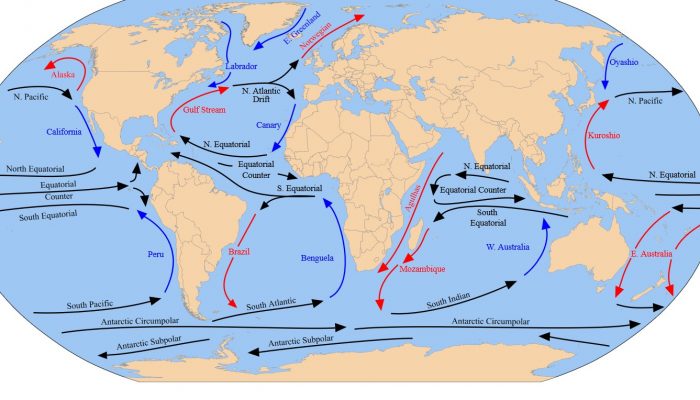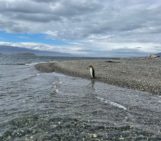
Navigating the ocean demands a knowledge of its movements. In the past, sailors have used this knowledge to their advantage, following the winds and the ocean currents to bring them on their way.
Prior to mutiny in 1789, Captain Bligh – on the HMS Bounty – famously spent a month attempting to pass westward through the Drake Passage, around Patagonia’s Cape Horn. Here the westerly winds were strong (as they are today) and drove the waters hard against the ship as it persisted against the flow. But they could not pass, and were forced to reach the Pacific by crossing back south of Africa, through the Indian Ocean, costing the mission many months.
It is the winds which predominantly drive the currents at the ocean’s surface. Depending on where you are on the planet, the winds blow in a variety of prevailing directions, exerting control over the surface of the oceans, over which they roll. Where the Earth’s westerlies prevail (moving eastwards, between the 30 to 60 degree latitude belt, in both hemispheres) we encounter some of the world’s fastest currents, including the Atlantic’s Gulf Stream, and the Kuroshio Current off Japan. These currents bring with them huge amounts of heat from tropical and subtropical areas; which is why Western Europe experiences much milder winters than other regions at similar latitudes (think Newfoundland, for example).
Also under the influence of the westerly winds is the world’s largest ocean current, the Antarctic Circumpolar Current, which circles Antarctica in the southern hemisphere. The Antarctic Circumpolar Current lies under the influence of the infamous Roaring Forties, Furious Fifties, and Screaming Sixties westerly wind bands, and acted as a major stretch along the historical clipper route between Europe, Australia, and New Zealand in the 19th century.
The trade winds (also known as the easterlies, circling the Earth between 0 and 30 degrees latitude, in both hemispheres) are typically weaker than the westerlies, but sufficiently strong to have enabled European expansion into the Americas over the centuries. The trades drive ocean currents such as the Canary Current and North Equatorial Current in the Atlantic Ocean, and the California Current and North Equatorial Current in the Pacific.
Also within these latitudes – particularly near the equator – are the doldrums, which are areas characterised by weak or non-existent winds. These regions became well known in the past as sailors were regularly stranded whilst crossing equatorial regions – immobile for days or weeks, resting in seas of calm – awaiting the winds to pick up and move them onwards.
As well as at the surface, the ocean is moving in its interior, with large scale sinking to depths of over 4000 meters in cold polar regions, and upwelling in the warmer tropics and subtropics. The ocean turns over on itself like a bathtub of water heated unevenly from above. Below the surface the deep waters move slowly (centimeters per second, rather than meters per second at the surface), mostly unaffected by wind. Here huge ocean scale water masses move (largely) because of density differences between regions, determined by variations in heat and salinity (salt content). Cold, salty water is dense, and sinks, while warmer water rises.
This large-scale overturning, which characterizes the movement of the world’s ocean as a whole, is known as the global conveyor belt, or the thermohaline circulation (thermo for heat, and haline for salt). Along the conveyor it takes thousands of years for water masses to complete a cycle around the planet.
But like many other features of our Earth system, it is now thought that the behaviour of the ocean’s circulation is beginning to change. Back at the surface oceanographers now expect that ocean currents will undergo substantial change in response to anthropogenic global warming. Computer simulations of the ocean and atmosphere are used to predict whether certain wind systems will strengthen or weaken in the future, and to look at the effect this might have on the underlying ocean currents.
We know from historical evidence that the strength of the ocean’s currents has varied in the past, so this coming century we can expect some changes along our ocean routes; an obvious and well highlighted example being the opening of commercial routes in the new ice-free Arctic.
Whatever the nature of the future ocean, modern technology including real-time satellite-sourced ocean data, and advanced ocean weather and wave forecasts, will allow us to constantly track changes, so that no matter the winds or current speeds, we should always be able to get where we’re going.
By Conor Purcell is a Science and Nature Writer with a PhD in oceanography.
Conor is based in Dublin, Ireland, and can be found on twitter @ConorPPurcell, with some of his other articles at cppurcell.tumblr.com. He is also the founder-editor at www.wideorbits.com.




